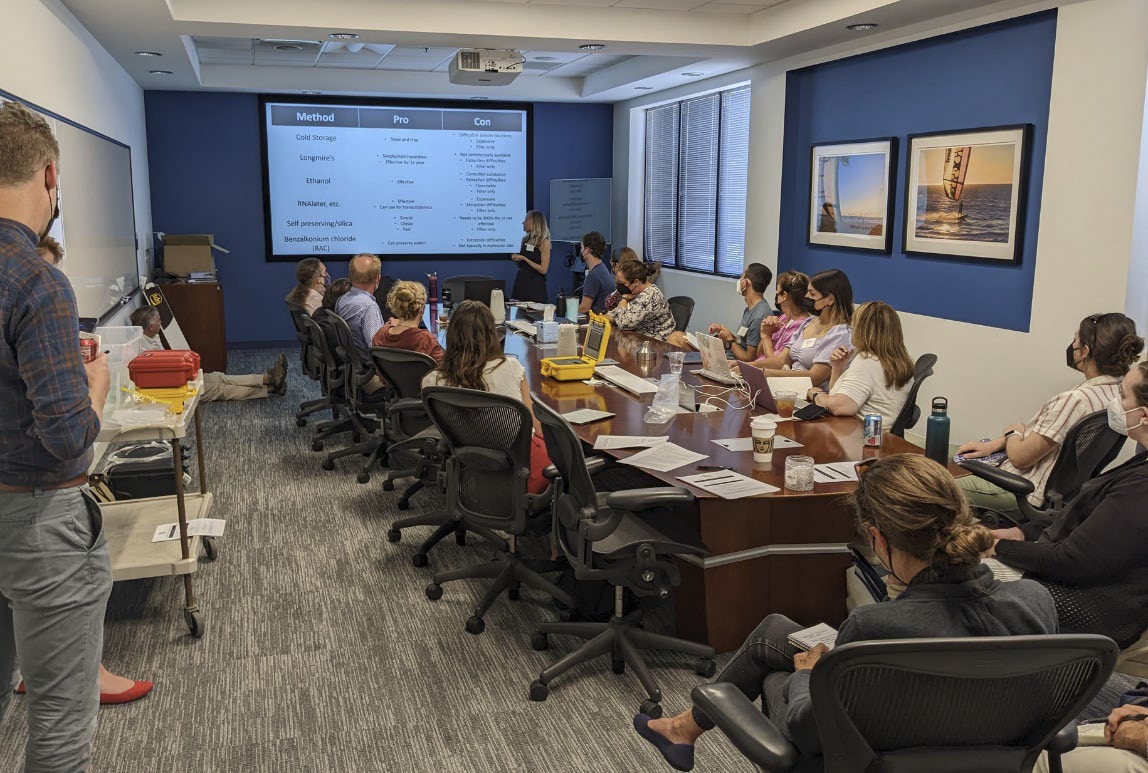Workshop works to transition eDNA methods to managers

More than 300 researchers and environmental managers gathered at SCCWRP and online during a national scientific workshop in September to coordinate and advance strategies for transitioning DNA-based methods for identifying aquatic organisms from pilot-scale studies to broad-scale adoption by the end-user management community.
The 2nd National Workshop on Marine Environmental DNA, hosted by SCCWRP, showcased for managers that identifying aquatic organisms by the DNA they shed into their environment, known as environmental DNA (eDNA), is a proven technology that is ready for incorporation into routine environmental management programs. The biggest remaining barrier is the lack of coordination among the many researchers and management agencies that are working – largely in siloes – to standardize eDNA sampling, processing and analysis protocols.
During breakout sessions at the conference, attendees identified the need to develop a coordinated national strategy to improve standardization and harmonization of eDNA methods across agencies and monitoring programs. Attendees also discussed the need to make strategic investments in building more DNA reference libraries for key biological communities.
California’s work in recent years to advance eDNA-based monitoring – an effort led by the California Water Quality Monitoring Council’s Molecular Methods Workgroup – is expected to serve as a template and a guide for developing a national eDNA implementation strategy. SCCWRP’s Dr. Susanna Theroux, who co-organized the conference, leads the California Molecular Methods Workgroup.
eDNA-based monitoring has the potential to serve as a cost-effective complement and/or alternative to traditional morphology-based monitoring, where specific types of aquatic organisms are sampled and identified to gain insights into biodiversity and ecosystem health. Managers can use eDNA-based methods
to monitor a broader range of organisms – from endangered species to invasive species – with greater speed and accuracy than traditional approaches.
The workshop – which attracted more than 100 attendees in person and 200 more online – included attendance by dozens of federal, State and local management agencies, as well as the White House, which kicked off the workshop with welcome remarks by Dr. Jane Lubchenco, Deputy Director for Climate and Environment at the White House’s Office of Science and Technology Policy.
The workshop is a follow-up to the 1st National Workshop on Marine Environmental DNA, held in 2018 in New York. Since that time, eDNA-based monitoring has evolved from a series of experimental, pilot-scale studies to a rigorously vetted science with potentially wide-ranging applications. Presenters at the SCCWRP workshop highlighted efforts to incorporate eDNA monitoring into broadscale fisheries stock assessments, marine mammal surveys and harmful algal bloom monitoring programs, among others.
Two SCCWRP member agencies – the State Water Resources Control Board and the City of San Diego – were among the participants in a roundtable panel discussion; they discussed the state of eDNA implementation within their agencies and remaining barriers and challenges.
The conference consisted of two days of public lectures, trainings and demonstrations, followed by two days of breakout sessions in which invited participants began discussing strategies and solutions for overcoming method adoption issues.
Within a year, attendees anticipate publishing a special issue of the journal Environmental DNA that articulates a coordinated strategy and roadmap for expeditiously building management capacity to incorporate eDNA-based methods into aquatic monitoring programs nationwide.
All recordings and presentation materials from the conference are available on the workshop’s website. For more information, contact Dr. Susanna Theroux.
More news related to: Bioassessment, DNA Barcoding, Top News